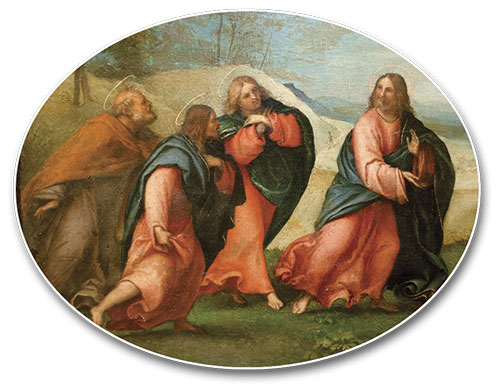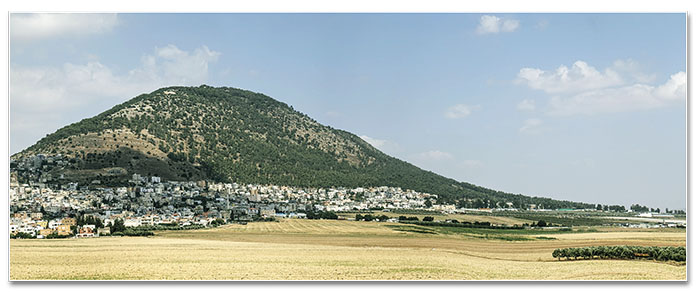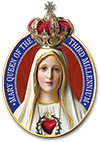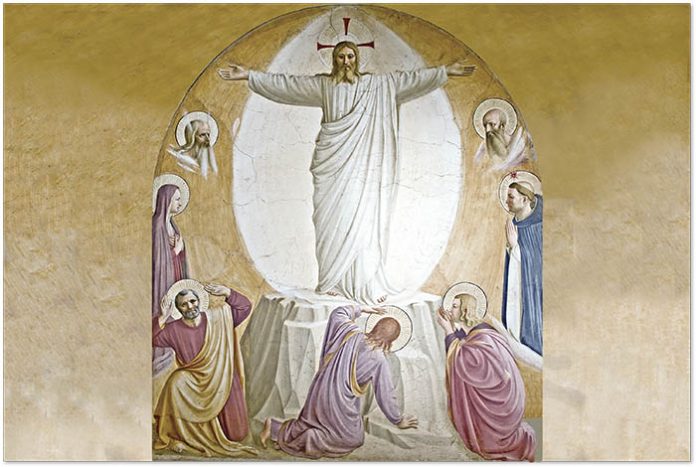Transfiguration of the Lord
The Manifestation of the Lord’s Glory
In leafing through the pages of the holy Gospels, we see that there is no other Transfiguration of Jesus besides the one of Tabor. It is true that after He resurrected, He appeared to the Apostles in the Cenacle (cf. Mk 16:14-18; Lk 24:36-49; Jn 20:19-29), to St. Mary Magdalene (cf. Mk 16:9; Jn 20:1-18) and to the Holy Women (cf. Mt 8:9-10), but nothing indicates that He showed them the resplendence described in this grandiose scene that we now contemplate. In it, He revealed a diminished reflection of His glory, concealing the plenitude of His splendour.
How can we interpret this sublime episode? What relationship does it have with us, two thousand years later? This passage offers many insights, with useful implications for the spiritual life.
It seems, at first, to have no obvious connection with the Christian vocation, so aptly outlined by the Second Vatican Council: “If therefore in the Church everyone does not proceed by the same path; nevertheless, all are called to sanctity and have received an equal privilege of faith through the justice of God (cf. Rom 12:4-5).”Perfection is not something exclusive to the clergy or religious, but should also shine in the laity, so that the Catholic spirit pervades the temporal reality. To be a saint, it is not necessary to perform miracles, or have extraordinary gifts or be transfigured, as Jesus was. Even in the Old Testament, God convoked Israel to holiness: “The Lord said to Moses, ‘Say to all the congregation of the people of Israel, you shall be holy, for I the Lord your God am holy’” (Lv 19:1-2). Consequently, it is not easy to establish a strict relationship between the general vocation of the sons of God to holiness and the Transfiguration of Our Lord, a miraculous phenomenon. Let us examine the question more closely.
Three chosen witnesses
28b Jesus took Peter, John and James and went up a mountain to pray.
When did the Transfiguration occur? According to St. Mark, six days, and St. Luke, eight days, after the decisive act in which St. Peter declared Jesus to be Christ, the Son of the living God (cf. Mt 16:13-17; Mk 8:27-30; Lk 9:18-21), and the Divine Master replied: “You are Peter, and on this rock I will build My Church, and the powers of death shall not prevail against it.” (Mt 16:18). Yet, directly following this, Jesus had foretold the sufferings that awaited Him in Jerusalem, even though His followers had not understood the meaning of His words.
The Apostles had followed Our Lord for some time, but, regrettably, had formed a twofold vision of Him. One was human, for, having assumed our nature, He suffered the needs of the human state. He felt hunger and thirst; He experienced fatigue, as, for example, in the dialogue with the Samaritan woman at Jacob’s well (cf. Jn 4:1-26), when He asked her for water as the Apostles went to buy food; or when He slept in the boat (cf. Mt 8:23-24; Mk 4:37-38; Lk 8:22-23). Alongside these common occurrences were episodes that demonstrated His superiority, such as His spending the entire night in prayer without this affecting His activity the next day (cf. Lk 6:12-13); healing the sick and casting out demons with all ease, by a simple command; and even His teaching a doctrine that was new and different from any school in existence, without having applied Himself to study. Both aspects presented a picture of Our Lord that was difficult to grasp at a glance… He exhibited alternately human and divine facets, and everyone, Apostles and disciples alike, could see that this was the Saviour. Yet because of their erroneous Messianic notions, seeing Him crucified would be a tremendous dashing of their hopes, and a shakeup of their convictions; they would suffer psychological disorientation. Their most ardent desires would clash with the painful outcome of the Passion; when faced with Christ’s death the crucial question would arise: Was He or was He not the promised Messiah?
Jesus, the zealous shepherd of His small flock, did everything to prepare them for these impending events. He knew how much they needed reinforcement and encouragement to stand fast in their faith. However, this was not to be given to all equally, as St. Thomas of Villanova affirms, in his explanation for why only three Apostles witnessed the wondrous scene of the Transfiguration: “So that the testimony of what was seen would be more firm and conclusive for the others, it was necessary to have few witnesses, so that sheer evidence and a high number of witnesses not let them lose the merit of faith.”Later, these three would sustain the others in their trial, mitigating their feelings of uncertainty at what seemed to be the Messiah’s defeat. Thus, supported by the words of those who had witnessed the Transfiguration, all would remain firm in the belief of the divinity of Jesus.
The ones who had been chosen would have to witness many of the humiliations of Our Lord Jesus Christ during the Passion and His Agony in the Garden of Olives. Providence normally asks more sacrifices of those who are more favoured by grace, those who are more loved. And if a person is privy to supernatural marvels, he will very possibly be put to the test to prove his love of God through his love of the cross. When the soul is bent under tribulations and the burden seems too much to bear, that is the time to recall that the cross is the sign of the predestined and that the time of trial foretells the hour of consolation. God always acts with balance, supporting souls in proportion to their needs.

The sight made such a deep impression on these three witnesses that it is narrated in all three synoptic Gospels, as well as in St. Peter’s reference to the voice of the Father in his second letter: “We ourselves heard this voice come from Heaven while we were with Him on the holy mountain” (2 Pt 1:18).
In his Gospel, St. John also records the splendorous vision of the glory of the Son of God, most likely referring to this episode with these words: “full of grace and truth; we have beheld His glory, glory as of the only Son from the Father” (Jn 1:14).

Glory manifested in refulgent light
29 While He was praying His face changed in appearance and His clothing became dazzling white.
Christ chose to reveal His glory “as He was praying.” This is a lesson for us, who often give little importance to prayer, putting the practical concerns of daily life first. Prayer makes our soul celestial; it is vital that we never leave off prayer.
How should Jesus’ dazzling appearance on this occasion be understood? He wished to show a flicker of what we will behold in Heaven. Actually, Peter, John, and James could not have contemplated the divinity of Our Lord with the sense of sight, since it is a reality that lies beyond the grasp of human nature on earth. We will only be able to see it in Heaven, with spiritual eyes. But during the Transfiguration, they captured what the human eye captures, that is, the exterior brilliance of the Sacred Body of the Lord. The glory of the Body was a reflection of the much more splendorous glory of the Soul.
The apogee of the Old Law bows before the Gospel
30 And behold, two men were conversing with Him, Moses andElijah, 31 who appeared in glory and spoke of His exodus that He was going to accomplish in Jerusalem.
Moses was the high point of the impressive history of the Hebrew people, marked by great figures such as Abraham, Isaac, Jacob, Joseph, and many others. The life of this providential man is filled with amazing events. He is, perhaps, unequalled in the Old Testament, not only because of his important calling, but also for his intimacy with God, which was such that the Sacred Author affirms: “Thus the Lord used to speak to Moses face to face, as a man speaks to his friend” (Ex 33:11). Elijah, for his part, whose life was also characterized by divine action and grandeur, was considered the apogee of prophetism, and was revered in a special way by pious Israelites, for his mission was not completed. Despite having been mysteriously taken up in a fiery chariot, the prophet Malachi prophesied his eventual return to fulfil yet another special mission pertaining to the Chosen People (cf. Mal 3:23-24). Because of this set of circumstances, his memory endured almost as if he yet lived among them.
The fact that both appeared on Mount Tabor, undoubtedly assuming an attitude of submission to Jesus – the details of which the simple evangelical narration does not give – was further confirmation to the three witnesses of what the Transfiguration was saying: Jesus Christ is truly the promised Messiah, the Son of God.
An enormous grace that escaped their understanding
32 Peter and his companions had been overcome by sleep, but becoming fully awake, they saw His glory and the two men standing with Him. 33 As they were about to part from Him, Peter said to Jesus, “Master, it is good that we are here; let us make three tents, one for You, one for Moses, and one for Elijah.” But he did not know what he was saying.
Peter’s reaction shows how difficult it was for him to refrain from expressing in words all that unfolded before him. And there was good reason for what he said, for it reflected the desire to perpetuate that state of paradisiacal felicity.
They were enraptured by marvels the likes of which they had never seen, yet they were afraid (cf. Mk 9:5-6), for they still had a degree of attachment to many principles that did not correspond with what was happening in their sight. The desire for a temporal Messiah who would resolve Israel’s problems was eclipsed by this magnificent scene. In seeing Jesus’ resplendence, they likely did not understand the full scope of the Transfiguration, for they were not yet prepared to assimilate everything He had to impart. The true notion of the Saviour had yet to be formed in their spirits and that episode clashed with the distorted concepts that held sway in their minds. This contradiction did not keep them from experiencing what a body is like after reuniting with its own soul. “Now faith” – St. Paul tells us – “is the assurance of things hoped for, the conviction of things not seen” (Heb 11:1). And in that instant they had a foretaste of a reality announced by faith, namely, the splendour pertaining to a glorious body. Grace was not lacking, for if Our Lord transfigured Himself without supporting them with especially sensible supernatural assistance, what good would it do? Reason alone could not sustain them, for these graces with which God educates and leads us to sanctity are essential.
Adoptive sons, God loves us as an only child
34 While he was still speaking, a cloud came and cast a shadow over them, and they became frightened when they entered the cloud. 35 Then from the cloud came a voice that said, “This is My chosen Son; listen to Him.”
The phenomenon narrated in these verses took place to ground the tremendous importance of this vision even more deeply in the sensibility of the Apostles. Let us pause to reflect on the word “Son.” Our Lord Jesus Christ is the Second Person of the Blessed Trinity, God the Son, the only Son begotten of the Father. But we are included in this sonship, for we are adoptive sons of God by Baptism. We are thus Jesus’ brothers, and part of the divine family. The glory revealed on Tabor was a foretaste of the eternal glory that awaits us, if we are faithful to this sublime condition. For this we must “listen to Him,” for “you have one master, the Christ” (Mt 23:10).
In “My chosen Son,” the Father deposited everything He could – infinite Goodness, Truth and Beauty. To us also, His chosen ones, He grants measureless gifts in Baptism and in all the other Sacraments. It was He Who instilled whatever good is in us, through His love. To be loved by God is an extraordinary privilege that we should jealously guard, by fleeing from sin. And if we are ever so unfortunate as to lose the state of grace, we should immediately set out to regain God’s friendship, following the path of repentance to the merciful tribunal of Penance.

Consolations do not last forever
36 After the voice had spoken, Jesus was found alone. They fell silent and did not at that time tell anyone what they had seen.
In this world, every joy comes to an end. After this great mystical experience, the three Apostles had to descend the mount and turn to evangelization with all of its obstacles and difficulties. When sensible grace ceases we are left with cooperative grace – which never fails – but which requires our collaboration, which is often inadequate. This is where problems start, since in day-to-day life we lack the clarity of understanding of the supernatural life that we have when operative grace is acting in us.3
The Evangelists describe how the Apostles struggled with the topic of Death and Resurrection presented to them by Our Lord on Tabor (cf. Mt 17:21-22; Lk 9:44-45; Mk 9:31-32), tending to interpret what they had seen according to human criteria – in the other evangelical narration they asked one another what “the rising from the dead meant” (Mk 9:10) – and, shortly after, they argued about who would be greater (Lk 9:46). They had already forgotten the consolations of the Transfiguration. And at the dolorous spectre of Christ’s Passion, they wavered and fled.
There is a lesson in this for our spiritual life. In order not to lose sight of the supernatural and fall into temptation, we should revolve our lives around the outlook that mystical graces provide. They are much more frequent in the spiritual life of the faithful than we imagine, and are valuable aids for persevering through difficult times.

